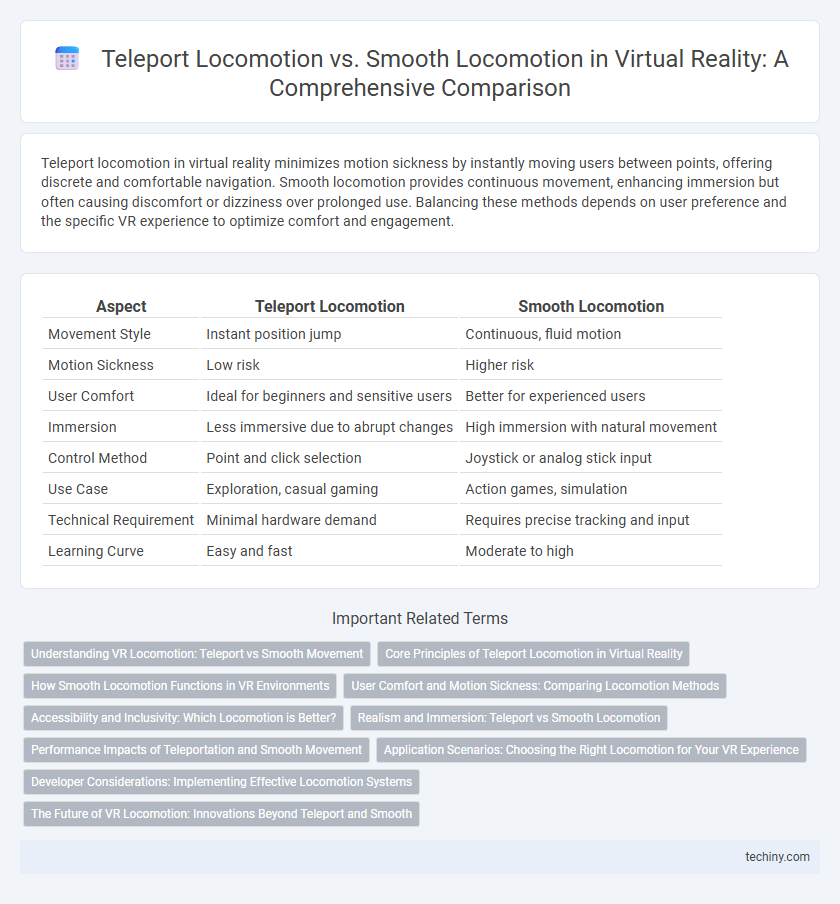Teleport locomotion in virtual reality minimizes motion sickness by instantly moving users between points, offering discrete and comfortable navigation. Smooth locomotion provides continuous movement, enhancing immersion but often causing discomfort or dizziness over prolonged use. Balancing these methods depends on user preference and the specific VR experience to optimize comfort and engagement.
Table of Comparison
| Aspect | Teleport Locomotion | Smooth Locomotion |
|---|---|---|
| Movement Style | Instant position jump | Continuous, fluid motion |
| Motion Sickness | Low risk | Higher risk |
| User Comfort | Ideal for beginners and sensitive users | Better for experienced users |
| Immersion | Less immersive due to abrupt changes | High immersion with natural movement |
| Control Method | Point and click selection | Joystick or analog stick input |
| Use Case | Exploration, casual gaming | Action games, simulation |
| Technical Requirement | Minimal hardware demand | Requires precise tracking and input |
| Learning Curve | Easy and fast | Moderate to high |
Understanding VR Locomotion: Teleport vs Smooth Movement
Teleport locomotion in VR instantly moves the user to a target location, minimizing motion sickness and offering precise navigation in confined spaces. Smooth locomotion simulates natural walking by continuously moving the user, providing immersive exploration but often causing discomfort for sensitive users. Balancing user comfort and immersion is essential when choosing between teleport and smooth movement strategies in virtual reality environments.
Core Principles of Teleport Locomotion in Virtual Reality
Teleport locomotion in virtual reality is grounded in the principle of instant positional displacement, allowing users to move across virtual environments without inducing motion sickness commonly associated with smooth locomotion. This method involves selecting a destination point within the VR space, then instantly transporting the user's viewpoint to that location, minimizing sensory conflicts between visual inputs and the vestibular system. Core principles emphasize comfort, reducing cybersickness, and maintaining spatial orientation through discrete, non-continuous movement strategies.
How Smooth Locomotion Functions in VR Environments
Smooth locomotion in VR environments functions by continuously translating the user's movement inputs into fluid, real-time motion within the virtual space, enhancing immersion and spatial awareness. This method uses analog stick or controller sensors to simulate natural walking or running, reducing motion sickness when implemented with careful acceleration and deceleration algorithms. Precise head tracking and frame rate optimization are critical for smooth locomotion to maintain user comfort and prevent disorientation during extended VR sessions.
User Comfort and Motion Sickness: Comparing Locomotion Methods
Teleport locomotion in virtual reality significantly reduces motion sickness by minimizing visual-vestibular conflicts, enhancing overall user comfort during extended sessions. In contrast, smooth locomotion offers more natural movement but increases the risk of nausea and disorientation due to continuous camera motion. Studies indicate that integrating comfort settings, such as customizable speed and vignette effects, can mitigate adverse effects associated with smooth locomotion while preserving immersion.
Accessibility and Inclusivity: Which Locomotion is Better?
Teleport locomotion significantly reduces motion sickness and discomfort, making it a more accessible option for users prone to VR-induced nausea or vestibular disorders. Smooth locomotion offers a more immersive experience but can exclude individuals with balance or sensory processing issues, limiting inclusivity. Prioritizing user comfort and minimizing adverse effects, teleport locomotion emerges as the better choice for accessible and inclusive VR environments.
Realism and Immersion: Teleport vs Smooth Locomotion
Smooth locomotion in virtual reality offers a continuous movement experience that enhances realism by mimicking natural walking or running, significantly boosting user immersion. Teleport locomotion, while reducing motion sickness by instantly repositioning users, can disrupt the sense of presence due to its fragmented transitions. Choosing between teleport and smooth locomotion depends on balancing comfort with the desired level of immersive realism in a virtual environment.
Performance Impacts of Teleportation and Smooth Movement
Teleport locomotion in virtual reality significantly reduces motion sickness and cognitive load by instantly repositioning users, leading to improved comfort and longer play sessions. However, teleportation can disrupt user immersion due to abrupt spatial jumps, potentially impacting the continuity of experience in VR environments. Smooth locomotion offers continuous movement that enhances realism and spatial awareness but may cause higher incidence of motion sickness and increased computational demand due to constant rendering of motion blur and dynamic environmental updates.
Application Scenarios: Choosing the Right Locomotion for Your VR Experience
Teleport locomotion excels in applications requiring user comfort and minimizing motion sickness, making it ideal for long-duration sessions or for users new to VR. Smooth locomotion offers a more natural and immersive movement experience, preferred in fast-paced games or simulations demanding precise spatial awareness and fluid navigation. Selecting the right locomotion depends on the VR application's goals, user experience levels, and the tolerance for motion sickness within the target audience.
Developer Considerations: Implementing Effective Locomotion Systems
Developers must balance user comfort and immersion when choosing between teleport locomotion and smooth locomotion in VR environments, prioritizing minimizing motion sickness and optimizing navigation fluidity. Teleport locomotion reduces discomfort by instantly repositioning users, making it ideal for sensitive players or complex spatial designs, whereas smooth locomotion offers more natural movement but requires careful tuning of speed and acceleration. Implementing adaptive systems that allow users to switch modes based on preferences and context enhances accessibility and broadens the appeal of VR applications.
The Future of VR Locomotion: Innovations Beyond Teleport and Smooth
Emerging VR locomotion techniques are transcending traditional teleport and smooth movement by integrating advanced haptic feedback, eye-tracking, and AI-driven environmental adaptations. These innovations prioritize natural user interactions and reduce motion sickness, enhancing immersion and accessibility in virtual environments. Research from institutions like Stanford and companies such as Oculus and Valve reveal that hybrid locomotion models could define the future of VR navigation.
Teleport locomotion vs Smooth locomotion Infographic

 techiny.com
techiny.com